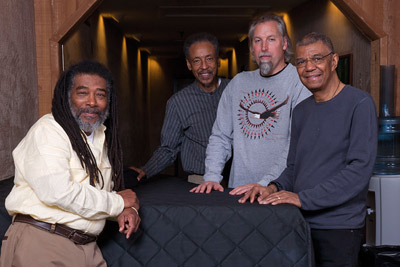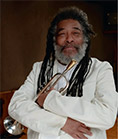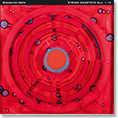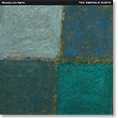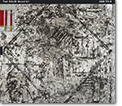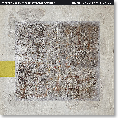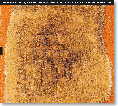THE MUSICIANS
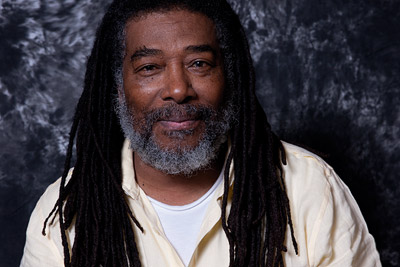
Wadada Leo Smith (b. 1941) was born in Leland, Mississippi. Smith´s early musical life began in the concert and marching bands of Lincoln High School in Leland, first on the mellophone, then moving on to the French horn and finally receiving his first trumpet at the age of 12. At the same age, he also composed a work for three trumpets, his first composition.
Smith received his initial musical education from his stepfather, Alex "Little Bill" Wallace, who was one of the first Delta blues singers to begin playing the electric guitar. His family home in Leland was a meeting place for musicians where blues artists, such as Elmore James, B.B. King and Little Minton, were frequent guests, often performing in the family´s living room. Accordingly, Smith has said that: "The Blues was my first language and it never went away." As a trumpeter, Smith considers himself a descendant of Louis Armstrong, although Miles Davis, Booker Little, Clifford Brown and, a bit later, Don Cherry had the strongest impact on his own playing as a young musician.
Smith´s formal music studies began with Earl Jones and Henderson Howard, who were his school bandmasters at Lincoln High, with the latter also being his first trumpet teacher. Smith later studied at the U.S. Army School of Music at Fort Leonard Wood in Missouri (1963), the Sherwood School of Music in Chicago, Illinois (1967-69), and the Wesleyan University in Middlewood, Connecticut (1975-76). His own music theory and notational system for improvisation in an ensemble context, which he calls "Ankhrasmation," has been significant in his development as an artist and educator. Smith published his music philosophy already in the early 1970s in notes (8 pieces), source a new world music: creative music (Kiom Press, 1973).
After high school, Smith travelled for about a year with various blues, rhythm ‘n´ blues and soul groups before entering the U.S. Army. In addition to attending the U.S. Army School of Music, Smith played for a total of about five years in six different army bands, touring not only in the Southern United States, but also in France and Italy. He also continued to broaden his musical horizons and was leading his own Ornette Coleman-inspired trio while still in the military. In 1967, Smith left the army and moved to Chicago to work with saxophonist Anthony Braxton and other members of the Association for the Advancement of Creative Musicians (AACM), the creative music collective that combined the music´s African roots with an improvisational approach.
Soon after his arrival in Chicago, Smith met Anthony Braxton and violinist Leroy Jenkins for an impromptu practice session and, as a result, the three founded the Creative Construction Company, a collaborative group that became one of the key early ensembles of the AACM. Smith´s other collaborators in the pioneering work of the AACM included saxophonists Joseph Jarman, Roscoe Mitchell and Kalaparusha Maurice McIntyre, trumpeter Lester Bowie, trombonist George Lewis and pianist Muhal Richard Abrams.
Smith´s first recordings were also made in Chicago during this period under the leadership of Braxton (3 compositions of new jazz in 1968 and Silence in 1969; these albums included Smith´s first recorded compositions, "The Bell" and "Silence," respectively, which already used the rhythm-units concept, a framework for improvisation that Smith developed more fully in the 1970s), McIntyre (Humility In The Light Of The Creator in 1969) and Abrams (Young At Heart, Wise In Time in 1969).
Like many other AACM members, Smith supported himself by playing in the horn sections of various rhythm ‘n´ blues and soul bands, including Little Milton Campbell´s group. In 1969, Smith turned down Little Milton´s offer to become the straw-boss of his road band and moved to Paris together with Anthony Braxton and Leroy Jenkins as well as a few other key members of the AACM. During his year in Paris, Smith took part in two important recordings by Braxton for the BYG Actuel label (Anthony Braxton in 1969 and This Time… in 1970) with a quartet that also included Jenkins and drummer Steve McCall. However, perhaps the most legendary line-up of this period was an expanded version of the Creative Construction Company (with Smith, Braxton, Jenkins, Muhal Richard Abrams, bassist Richard Davis and McCall), which was recorded live in May 1970 in connection with the AACM´s first concert in New York City (Creative Construction Company and Creative Construction Company 2). Smith worked with Braxton throughout the 1970s, including in Braxton´s quartet with Smith, bassist Dave Holland and drummer Phillip Wilson and other small groups as well as on Braxton´s classic big band recordings, Creative Orchestra Music 1976 and Creative Orchestra (Koln) 1978. Since that time, Braxton and Smith have continued to play together from time to time.
After his year in Paris, Smith led his own group, Integral,with saxophonist Henry Threadgill, trombonist Lester Lashley and drummer Thurman Baker, for a few months in Chicago before settling in New Haven, Connecticut, during the summer of 1970 for a period of ten years. In New Haven, Smith concentrated on his own music as well as studying and teaching rather than touring and recording all over the world like many of his compatriots. In addition to leading his own groups and teaching at the University of New Haven, he studied ethnomusicology at the Wesleyan University, focusing on West African, Japanese, Indonesian and Native American music cultures. Soon after arriving in New Haven, Smith organized the Creative Improvisation Ensemble with saxophonist Marion Brown and they also recorded a duo album in December 1970 in New York City (Creative Improvisation Ensemble/Duets).
Smith´s first recording as a leader was a solo album (Creative Music-1 in 1971), which was also the first album released on Kabell, the independent record label he founded. After this first solo recording, Smith has continued to perform solo concerts and has recorded three additional solo albums (Solo Music/Ahkreanvention in 1979, Kulture Jazz in 1992 and Red Sulphur Sky in 2001).
Smith´s principal ensemble in New Haven, New Dalta Akhri, was comprised of his students and other young musicians based in the area and recorded a number of albums (Reflectativity, Song of Humanity, The Mass Of The World, Divine Love, Spirit Catcher and Go In Numbers). At various times, its members included saxophonists Dwight Andrews, Oliver Lake and Henry Threadgill, pianist Anthony Davis, vibraphonist Bobby Naughton, guitarist Michael Gregory Jackson, bassist Wes Brown and drummer Pheeroan akLaff. Members of New Dalta Akhri were also part of the two large orchestras responsible for Smith´s first big band recordings, Leo Smith Creative Orchestra (Budding Of A Rose in 1979) and Leo Smith & The Creative Improviser Orchestra (The Sky Cries The Blues in 1981).
During the New Haven period, Smith recorded as a member of the Jazz Composer´s Orchestra under the direction of trumpeter/trombonist Clifford Thornton (The Gardens Of Harlem in 1974) and Leroy Jenkins (For Players Only in 1975). He also recorded with Marion Brown (Geechee Recollections in 1973), saxophonist Frank Lowe (The Flam in 1975 and Doctor Too-much in 1977), Bobby Naughton (The Haunt in 1976), Michael Gregory Jackson (Clarity in 1976), Phillip Wilson (Fruits in 1978) and Roscoe Mitchell (Sketches From Bamboo in 1979) and began his longstanding relationship with certain key figures in European improvised music, such as guitarist Derek Bailey (Company 5, Company 6 and Company 7, all in 1977, with the collective personnel of Bailey, trumpeters Smith and Steve Beresford, saxophonists Anthony Braxton, Steve Lacy, Evan Parker and Lol Coxhill, cellist Tristan Honsinger, bassist Maarten Altena and drummer Han Bennink) as well as bassist Peter Kowald and drummer Günter "Baby" Sommer (Touch The Earth in 1979 and If You Want The Kernels, You Have To Break The Shells in 1981).
In the early 1980s, Smith converted to Rastafarianism and recorded a series of albums that reflected this new spirituality, including Human Rights, Procession Of The Great Ancestry and Rastafari. The music that Smith performed around this time sometimes featured lyrics inspired by Rastafarianism and introduced elements of fusion jazz, reggae, funk and the blues into the music. Smith also became increasingly interested in presenting multi-media performances incorporating song, dance and drama.
In 1986, Smith began a series of trumpet/drums duos by recording a live concert with drummer Ed Blackwell (The Blue Mountain´s Sun Drummer,released on Smith´s Kabell label in 2010). This series also includes duo recordings with Adam Rudolph (Compassion in 2002), Günter "Baby" Sommer (Wisdom In Time in 2006), Jack DeJohnette (America in 2008) and Louis Moholo-Moholo (Ancestors in 2011, TUM CD 029). In recent years, Smith has also made a number of other duo recordings, including those with vibraphonist Gustavo Aguilar, trombonist Jeb Bishop, Anthony Braxton, guitarist John Coxon, pianist Matthew Goodheart, laptop computer artist Ikue Mori and poet Harumi Makino Smith.
* In 1993, Smith accepted a teaching position at the California Institute of the Arts and has made Southern California his home ever since although he recently retired from full-time teching. Alongside teaching, Smith continued to lead his own groups, in particular N´Da Kulture, and recorded a number of highly acclaimed albums (e.g., Tao-Njia, Golden Hearts Remembrance, Light Upon Light, Luminous Axis and Reflectativity) as a leader. In the mid-1990s, Smith had converted to Islam, which further strengthened and made more apparent his longstanding interest in the musical cultures of the East, including those of Japan and India.
* After his move to California, Smith began performing with other improvising musicians based on the West Coast, such as saxophonists Mario Eneidi and Vinny Golia, bassists Adam Lane and Bertram Turetzky, members of the Rova Saxophone Quartet and guitarist Henry Kaiser (in Yo Miles!, a group co-led by Kaiser and Smith and dedicated to the music of Miles Davis´ electric period), while continuing his collaborations with the likes of Anthony Braxton, Douglas Ewart, Susie Ibarra, John Lindberg, Roscoe Mitchell, Matthew Shipp, Spring Heel Jack and John Zorn, among many others.
Smith currently leads four principal ensembles of his own: Golden Quartet, an all-star group that originally included pianist Anthony Davis, bassist Malachi Favors Magoustous and drummer Jack DeJohnette and, in later editions, pianist Vijay Iyer or Angelica Sanchez, bassist John Lindberg and drummer Pheeroan akLaff or Shannon Jackson (Golden Quartet in 2000, The Year Of The Elephant in 2002, Tabligh in 2005 and, expanded into the Golden Quintet with drummer Don Moye, Spiritual Dimensions-CD1 in 2008); Mbira, a trio with pipa player Min Xiao-Fen and Pheeroan akLaff (Dark Lady of the Sonnets in 2007, TUM CD 023); Organic, a larger group with instrumentation consisting primarily of electric string instruments (Spiritual Dimensions-CD2 in 2008 and Heart´s Reflections in 2010); and the Silver Orchestra, a large orchestra that recorded its first album in 2004 (Lake Biwa).
Smith has been a prolific composer throughout his career with works ranging from solo piano pieces to compositions for multiple orchestras. Already while in the military in the 1960s, Smith arranged both popular and classical music for the various military bands he played in and also increasingly began composing his own music both for jazz groups and other ensembles. By the time Smith moved to Chicago in 1967, he had already composed several string quartettos and orchestral works. When working with other members of the AACM and, in particular, in the large ensembles led by Muhal Richard Abrams and others, Smith began to combine his compositional skills and the improvisational spirit of the early AACM ensembles in search of his own approach to orchestral improvisation.
By 1970, Smith had developed the two basic systems of music that he has utilized in his compositions ever since: the system of rhythm-units and the notation system he termed "ahkreanvention," which literally means to create and invent musical ideas simultaneously, utilizing the fundamental laws of improvisation and composition. With the rhythm-unit concept, each single sound or rhythm, or series of sounds or rhythms, is accepted as a complete piece of music. Each performer, in turn, is considered as a complete unit with each having his or her own center from which each performs independently of any other, whether performing in a small group or in an orchestral context. The independence of each sound-rhythm and the independence of each performer contributes to the liberation from time as a period of development and to its employment as an element of space instead.
Smith´s music for large ensembles has been performed throughout the world since 1969, developing from early works for more traditional big bands to compositions for multi-ensembles. Smith has received a number of awards and commissions as a composer and his compositions have been performed by numerous contemporary music ensembles, including the AACM Orchestra, the Kronos Quartet, the Da Capo Chamber Players, the New Century Players, the San Francisco Contemporary Music Players, the Contemporary Chamber Players (University of Chicago), the S.E.M. Ensemble, the Southwest Chamber Music, the Del Sol String Quartet, the New York New Music Ensemble, ne(x)tworks, the California E.A.R. Unit and the Oxford Improvisers Orchestra, among others.
In May 2012, Smith released his most extensive recording to date, Ten Freedom Summers, a four-CD collection of a total of 19 works composed over a period of 34 years and inspired by the civil rights movement in the United States. Ten Freedom Summers was recorded by the Golden Quartet (Smith, Anthony Davis, John Lindberg and Pheeroan akLaff) and the Golden Quintet (add drummer Susie Ibarra) together with Southwest Chamber Music and was short-listed for the Pulitzer Prize in Music.
In 2013, Smith released another important recording of larger works, Occupy The World (TUM CD 037-2), comprised of six extended compositions performed by TUMO, a 22-member improvising orchestra.
...
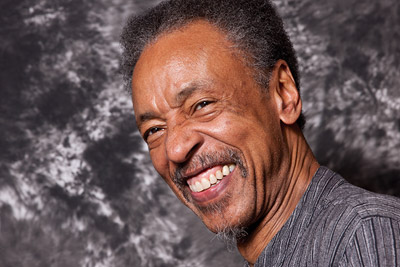
Henry Threadgill (b. 1944) was born on the South Side of Chicago, Illinois, and grew up surrounded by music of various kinds - classical, jazz, gospel and blues. His extended family included an aunt, who studied classical piano and voice, and an uncle, Nevin Wilson, who played bass in pianist Ahmad Jamal´s trio.
Threadgill attended Chicago´s Englewood High School with the likes of future AACM members Steve McCall and Roscoe Mitchell. At Englewood, Threadgill began playing the tenor and then baritone saxophone, inspired by local saxophonists, such as Gene Ammons, John Gilmore, Eddie Williams and later also Von Freeman and Clifford Jordan. As a teenager, Threadgill regularly attended rehearsals and performances by the Sun Ra Arkestra.
After high school, Threadgill played with Veterans of Foreign Wars (VFW) marching bands in parades, as well as with blues, mariachi, gospel and polka bands. He attended Wilson Junior College, where he met musicians who later joined the AACM, including Anthony Braxton, Ari Brown, Malachi Favors, Joseph Jarman and Roscoe Mitchell. Jack DeJohnette, Betty Dupree, Bunky Green and Eddie Harris were also students at Wilson.
Threadgill and others soon joined Muhal Richard Abrams´ music workshop, which became known as the Experimental Band and laid the groundwork for the AACM. Every member was expected to compose music, with a part for every musician in the ensemble, regardless of instrument. Threadgill recalls first creating a piece for the Experimental Band around 1962.
After Wilson, Threadgill studied at the Governors State University and then at the American Conservatory of Music in Chicago, where he studied piano with Gail Quillman and composition with Stella Roberts, among others, and received a degree in flute performance and composition.
In 1963 and 1964, Threadgill toured the United States with Philadelphia-based evangelist Horace Shepherd. In the late 1960s, he also toured with gospel singer Jo Jo Morris.
Threadgill was among the earliest members of the AACM, which was founded in May 1965. However, like many of his AACM colleagues, Threadgill had to leave Chicago for military service in 1966. He first worked in the U.S. Army as a musician and arranger but was then sent to Vietnam. Threadgill returned to Chicago in 1968 and joined the AACM Big Band and also worked with Philip Cohran, one of the AACM´s original founders. He stayed briefly in New York City in 1969, but soon returned to Chicago, where he recorded for the first time with Muhal Richard Abrams´s quintet (Young At Heart, Wise In Time) that same year.
In the early 1970s, Threadgill focused on composing for and leading his own groups. The first of these was Air, a collaborative trio with bassist Fred Hopkins and drummer Steve McCall. With Air, Threadgill played saxophones and the hubkaphone, a found-sound percussion instrument that he had built out of hubcaps. Initially called Reflection, the trio was formed for the 1971 centennial celebration of ragtime composer Scott Joplin´s birth. The trio renamed itself Air after moving in 1975 to New York City, where many of the other AACM members had also moved.
Air toured widely and recorded nine albums mostly comprised of Threadgill´s compositions (Air Song in 1975, Live Air and Air Raid in 1976, Air Time in 1977, Open Air Suite and Montreux Suisse Air in 1978, Air Lore in 1979, Air Mail in 1980 and 80 Deg Below in 1982). Perhaps the best known of these is Air Lore, which, in a return to the trio´s roots, included arrangements of Scott Joplin rags and two Jelly Roll Morton compositions. A reconfigured trio, New Air (with Pheeroan akLaff replacing McCall on drums), recorded two albums in the mid-1980s (New Air: Live At Montreal International Jazz Festival in 1983 and Air Show No. 1 with Cassandra Wilson in 1986).
In New York City, Threadgill also embarked on various larger-scale projects under his own name. The first of these was X-75, which used four basses (Fred Hopkins, Leonard Jones, Rufus Reid and Brian Smith), four woodwinds (Threadgill, Douglas Ewart, Joseph Jarman and Wallace Laroy McMillan) and a vocalist (Amina Claudine Myers). The group released only one album, X-75 Volume 1 (1979), although Volume 2 has subsequently been released in a Mosaic boxed set (The Complete Novus & Columbia Recordings of Henry Threadgill & Air).
In addition to his own projects, Threadgill worked extensively with a number of other groups, including the David Murray Octet (Ming in 1980, Home in 1981 and Murray´s Steps in 1982) and Bill Laswell´s collective, Material (Memory Serves in 1981 and The Third Power in 1991). During this period, he also recorded with Chico Freeman (Morning Prayer in 1976), Roscoe Mitchell (Nonaah in 1977 and L-R-G in 1978), Anthony Braxton (For Trio in 1977), Muhal Richard Abrams (I-OQA+19 in 1977), Frank Walton (Reality in 1978) and Douglas Ewart (Angles Of Entrance in 1990), among others, and participated in various projects by Hal Willner (Amarcord Nino Rota in 1979-80, Lost In Stars in 1985 and Weird Nightmare in 1992) and Kip Hanrahan (Darn It! in 1992 and A Thousand Nights And A Night in 1994-96).
Following Air, Threadgill put together the Henry Threadgill Sextet, or Sextett, which became his most visible group for a number of years (When Was That? in 1982, Just The Facts And Pass The Bucket in 1983, Subject To Change in 1984, You Know The Number in 1986, Easily Slip Into Another World in 1987 and Rag, Bush & All in 1988). The Sextett featured instrumental pairs, which allowed Threadgill to compose for "sections" of strings, brass and percussion, including double bass (Fred Hopkins) and cello (Diedre Murray), trumpet (Olu Dara et.al.) and trombone (Craig Harris et.al.), and two drummers (Pheeroan akLaff and John Betsch et.al.). These three pairs combined to create the sound of a "sextet." Threadgill himself was a one-man woodwind section, playing alto saxophone, clarinet and various flutes.
In the early 1990s, Threadgill formed Very Very Circus, another highly acclaimed ensemble, which was composed of Threadgill´s reeds, trombone (Curtis Fowlkes) or French horn (Mark Taylor), two guitars (Brandon Ross and Masujaa), two tubas (Edwin Rodriguez and Marcus Rojas) and drums (Gene Lake) (Spirit of Nuff ... nuff in 1990, Live at Koncepts in 1991, Too Much Sugar For A Dime in 1993 and Carry The Day in 1994).
Gradually, Very Very Circus was replaced with Make A Move, with guitar (Brandon Ross), accordion ((Tony Cedras) or vibraphone (Bryan Carrott), electric bass (Stomu Takeishi), drums (J. T. Lewis or Dafnis Prieto) and Threadgill´s saxophone (Makin´ A Move in 1995, Where´s Your Cup? in 1996 and Everybody´s Mouth´s A Book in 2001).
Zooid is Threadgill´s latest actively performing and recording group and originally included guitar (Liberty Ellman), oud (Tarik Benbrahim), cello (Dana Leong), tuba (Jose Davila) and drums (Dafnis Prieto) along with the leader´s woodwinds (Up Popped The Two Lips in 2001, This Bring Us To, Volume I and Volume II in 2008 and Tomorrow Sunny/The Revelry, Spp in 2011).
Threadgill also leads the WindString Ensemble, which includes saxophone, violin, viola, cello and tuba, another section-based group he calls 3+3, with three cellos, tuba, drums and his flute and saxophone, and a marching band. His twenty-some-member Society Situation Orchestra has performed infrequently in the United States and abroad.
Over the years, much of Threadgill´s work has gone unrecorded, sometimes by choice. He has always preferred the interaction and unpredictability of group performances to solo work. His sideman recordings have also been few in the last two decades, with Billy Bang´s Vietnam project (Vietnam: Reflections in 2004) being one notable exception.
Threadgill´s compositional output is broad-ranging and he has written pieces for symphony and chamber orchestras, saxophone quartet, organ and orchestra, and an ensemble he conducts called Aggregation Orb, which includes French horn, clarinet, violin, viola, cello, acoustic guitar, oud, tuba, hand drums, drumset, vibraphone/marimba and vocals, among others. He has received numerous commissions and awards throughout his career.
...
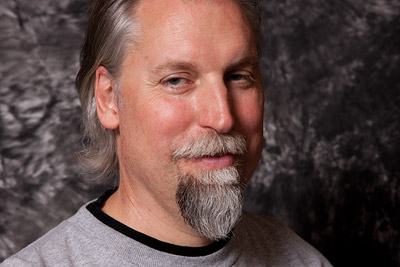
John Lindberg (b. 1959) was born in Detroit, Michigan, and grew up in the towns of Royal Oak and Marshall in Southern Michigan. He began playing percussion in school marching bands at the age of ten, moving to the drum set at the age of 14 after being inspired by a friend´s jazz album collection, which ranged from Louis Armstrong to the Art Ensemble of Chicago. Having shortly thereafter requested for a double bass at school, Lindberg dedicated himself to that instrument and to the study of creative music, including with saxophonist Roscoe Mitchell who lived nearby. Rather than finishing high school, at the age of sixteen, Lindberg chose to pursue a professional career in music; leaving his family home and beginning the life of a working musician. Among his early teachers at the Creative Music Studio in Woodstock, New York, in the mid-1970s were Dave Holland and David Izenson, with the latter also becoming an important mentor to Lindberg.
After settling in New York City, Lindberg played with saxophonists Frank Lowe (Lowe & Behold in 1977) and Marion Brown as well as in the Human Arts Ensemble alongside trombonist Joseph Bowie, saxophonist Luther Thomas, guitarist James Emery and drummer Charles "Bobo" Shaw (Junk Trap and Live In Trio Performances, Volume 1. in 1978). He also became a member of saxophonist Anthony Braxton´s quartet and other ensembles from 1978 until 1985 (Creative Orchestra (Koln) and Orchestra (Paris) in 1978, Performance 9-1-79 and Seven Compositions in 1979, Six Duets in 1982, Four Compositions (Quartet) in 1983 and Six Compositions (Quartet) and Prag 1984 (Quartet Performance) in 1984).
In 1977, Lindberg, James Emery and violinist Billy Bang co-founded the String Trio of New York (First String in 1979, Area Code 212 in 1980, Common Goal in 1981, Rebirth Of A Feeling in 1983 and Natural Balance in 1986), which quickly became both critically acclaimed and highly popular with international audiences. After Bang left to lead his own groups, the violin seat in the triohas been occupied by a succession of other fine violinists, including Charles Burnham (String Trio Of New York & Jay Clayton in 1987, Ascendant in 1990 and Time Never Lies in 1991), Regina Carter (Intermobility in 1992, Octagon in 1992, An Outside Job and Blues...? in 1993 and String Trio Of New York with Anthony Davis in 1996), Diane Monroe (Faze Phour in 1997) and, for the last 14 years, Rob Thomas (Gut Reaction in 2001, Frozen Ropes in 2004 and The River Of Orion in 2007).
From 1980 to 1983, Lindberg lived in Paris, performing with reed players John Carter, Tony Coe (Tournee Du Chat in 1982), Steve Lacy and Keshavan Maslak (Loved By Millions in 1980 and Big Time in 1981), among many others. He also formed a trio with saxophonist Jimmy Lyons and drummer Sunny Murray (Jump Up/What To Do About in 1980).
Lindberg´s compositions have been featured on more than 50 recordings by groups led or co-led by him. These include Duo (with Billy Bang) in 1979, Comin' And Goin (solo) in 1980, Unison (with Marty Ehrlich) and Dimension 5 (with Bang, Ehrlich, Hugh Ragin and Thurman Baker) in 1981, Team Work (with Ragin) and Give And Take (with George Lewis and Barry Altschul) in 1982, Haunt Of The Unresolved (with Ragin and Ehrlich) and The East Side Suite (with John Carter and Eric Watson) in 1983, Trilogy Of Works For Eleven Instrumentalists (large ensemble conducted by Anthony Braxton) and Relative Reliability (with Ragin and Baker) in 1984, Shoot First (with Eric Watson) in 1989, Luminosity (solo) and Dodging Bullets (with Albert Mangelsdorff and Watson) in 1992, Quartet Afterstorm (with Mangelsdorff, Watson and Ed Thigpen) in 1994, Resurrection Of A Dormant Soul (with Mangelsdorff, Watson and Thigpen) in 1995, Bounce (with Dave Douglas, Larry Ochs and Thigpen) in 1997, The Catbird Sings (with Wadada Leo Smith, Ochs and Andrew Cyrille) in 1999), A Tree Frog Tonality (with Smith, Ochs and Cyrille) in 2000, Two By Five (with the Ann Arbor String Quartet) in 2001, Ruminations Upon Ives And Gottschalk (with Baikida Carroll, Steve Gorn and Susie Ibarra) in 2001 as well as Winter Birds (with Carroll, Gorn and Ibarra) and Duets 1 (with Karl Berger) in 2004.
More recently, Lindberg has performed with his trio, BLOB, which also features guitarist Ted Orr and drummer Harvey Sorgen as well as occasional guests (The Awakening in 2007, Halloween and Quantum Fugue in 2008, Earphonious Swamphony and You Can't Get There From There… in 2009, Metalshop in 2010 as well as BLOB Goes To Mars and Third Ear in 2011). Lindberg also performs with Tripolar, with saxophonist Don Davis and drummer Kevin Norton ((a)live at Roulette, NYC, in 2011), and the genre-busting trio JazzHopRevolution, with lyricist/hip hop artist Rahman Jamal and drummer Tani Tabbal (The Sound of Truth in 2007).
In recent years, Lindberg has also been part of groups led by Karl Berger (Stillpoint in 2001/02), Susie Ibarra (Flower After Flower in 2000), Kevin Norton (Intuitive Structures in 2002 and Time-Space Modulator in 2004) and Roswell Rudd (The Incredible Honk in 2011), among others.
Beginning in 2005, Lindberg has been a member of various ensembles of Wadada Leo Smith, most notably the Golden Quartet, Organic and the Silver Orchestra (Lake Biwa in 2004, Tabligh in 2005, Spiritual Dimensions in 2008 and Heart´s Reflections in 2010). He was also featured on Smith´s recent recordings of extended compositions, Ten Freedom Summers in 2011 and Occupy The World (TUM CD 037-2) in 2012.
Lindberg has composed more than 150 pieces, including a number of extended works that have been commissioned by a variety of ensembles and organizations, such as the New York Chamber Ensemble, the Pittsburgh New Music Ensemble, WDR Radio, Leonardo String Quartet, Bermuda Triangle and Wiener Musik Galerie. He has also long been active in music education.
...
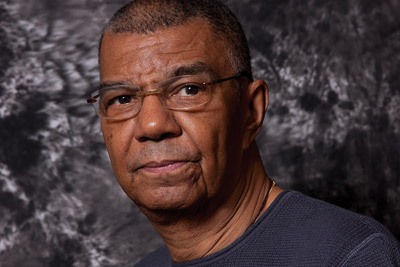
Jack DeJohnette (b. 1942) was born in Chicago and grew up in a family where music had a high priority. Beginning at the age of four, he studied classical piano at the Chicago Conservatory of Music, then added the drums to his repertoire when he joined his high school concert band at the age of 14.
By the mid-1960s, DeJohnette had entered the Chicago jazz scene - not just as a leader of his own groups, but also as a sideman on both piano and drums. He experimented with rhythm, melody and harmony as part of the AACMduring the organization´s early days, and later drummed alongside Rashied Ali in the John Coltrane Quintet.
Although DeJohnette´s first published recording was with Jackie McLean (Jacknife in 1965; also Demon´s Dance in 1967), he began garnering international recognition during his tenure with the Charles Lloyd Quartet (also Keith Jarrett and Cecil McBee or Ron McLure; Dream Weaver, Forest Flower and In Europe in 1966, Love-In - At The Fillmore and In The Soviet Union in 1967, and Soundtrack in 1968), one of the first jazz groups to receive true crossover attention. He also soon started recording with the likes of Herbie Hancock (Blow-Up in 1966), Jerry Hahn (Ara-be-in in 1967), Joe Hendersson (Tetragon in 1968), Bill Evans (At The Montreux Festival in 1968), Bobby Timmons (Do You Know The Way in 1968), Lee Konitz (Peacemeal in 1968), Eric Kloss (Sky Shadows in 1968), Chick Corea (Is in 1969) and Wayne Shorter (Super Nova in 1969), among many others, thereby beginning one of the most extensive recording careers in modern jazz.
In 1968, DeJohnette joined Miles Davis´s group just prior to the recording of Bitches Brew, an album that triggered a seismic shift in jazz and permanently changed the direction of the music. DeJohnette stayed with Davis for three years, making important contributions to a number of Davis recordings, including Live At The Fillmore East, Black Beauty and Live/Evil in 1970, A Tribute To Jack Johnson in 1971 and On The Corner in 1972.
During this same period, DeJohnette also recorded his first albums as a leader, including The DeJohnette Complex (with Bennie Maupin, Stanley Cowell, Miroslav Vitous and Roy Haynes) in 1968, Have You Heard? (with Maupin, Hideo Ichikawa and Gary Peacock) in 1970, Sorcery (with Maupin, Michael Fellerman, John Abercrombie, Mike Goodrich and Dave Holland) in 1974 and Cosmic Chicken (with Alex Foster, Abercrombie and Peter Warren) in 1975.
The mid-1970s were marked by a series of short-lived groups and projects - many of them leaning toward the more experimental side of jazz, including The Gateway Trio (featuring Dave Holland and John Abercrombie; Gateway in 1975 and Gateway 2 in 1977 as well as Homecoming and In the Moment in 1994), Directions (with Abercrombie, Alex Foster et. al.; Directions in 1975 and Untitled in 1976) and New Directions (with Abercrombie, Lester Bowie and Eddie Gomez; New Directions in 1978 and New Directions in Europe in 1979). These were followed by Special Edition, which helped launch the careers of several lesser-known musicians, such as Arthur Blythe, Chico Freeman, David Murray, John Purcell and Rufus Reid, and remained active for almost two decades (Special Edition in 1976, Tin Can Alley in 1980, Inflation Blues in 1982, Album Album in 1984, Irresistible Forces in 1987, Audio-Visualscapes in 1988, Earth Walk in 1991 and Extra Special Edition in 1994) although the group´s schedule was frequently interrupted by DeJohnette´s various collaborative ventures.
Alongside his own groups and other projects, DeJohnette has worked extensively with Keith Jarrett as part of a longstanding trio also including Gary Peacock. In a rare feat for a modern jazz group, this trio celebrated its 30th anniversary in 2013. The trio´s first recording session took place in 1983 producing Standards, Volume 1 and Volume 2 as well as Changes, and their oeuvre now totals approximately 20 recordings.
Another of DeJohnette´s high-profile projects in the early 1990s was a trio with Herbie Hancock and Pat Metheny (Parallel Realities in 1990), which developed into a touring quartet also including Dave Holland (Parallel Realities Live in 1990). In 1992, DeJohnette released Music For A Fifth World, an album inspired by Native American culture that included appearances by Vernon Reid and John Scofield, among others.
More recently, DeJohnette has performed with the Jack DeJohnette Quartet, featuring Danilo Perez, John Patitucci and Jerome Harris; and the Beyond Trio, a group that celebrated the music of Tony Williams, featuring John Scofield and Larry Goldings. Recent collaborations have also included duet recordings with Gambian kora player Foday Musa Suso (Music From The Hearts Of The Masters in 2002) and with Bill Frisell (The Elephant Sleeps But Still Remembers in 2001), Trio Beyond with Larry Goldings and John Scofield (Sausades in 2004) and a trio with Danilo Perez and John Patitucci (Music We Are in 2008). DeJohnette´s most recent recording as a leader is Sound Travels (2011), a genre-spanning album that features guest players such as Esperanza Spalding, Bobby McFerrin, Bruce Hornsby and Jason Moran. Currently, DeJohnette performs with the Spring Quartet (with Joe Lovano, Esperanza Spalding and Leo Genovese), and leads his own trio with Ravi Coltrane and Matthew Garrison.
Although identified by many with his most high-profile associations, such as Miles Davis, Herbie Hancock and Keith Jarrett, DeJohnette has always stayed true to his roots in the creative music of Chicago in the 1960s as evidenced by the personnel of many of his own groups and his collaborations with the likes of Ornette Coleman and Pat Metheny (Song X in 1985), David Murray (In Our Style in 1986), Dave Holland (Triplicate in 1988), Gary Thomas (Exile´s Game in 1993), the World Saxophone Quartet (Selim Sivad in 1998), Don Byron (Romance With The Unseen in 1999 and Ivey-Divey in 2004) and John Surman (The Amazing Adventures of Simon Simon in 1981, Invisible Nature in 2000, Free And Equal in 2001, Hybrids in 2005 and Brewster´s Rooster in 2007), among many others.
During the last 15 years, DeJohnette has also performed with Wadada Leo Smith, whom he first played with in Chicago in the 1960s. DeJohnette was one of the original members of Smith´s Golden Quartet (with Anthony Davis and Malachi Favors Maghostut; Golden Quartet in 2000 and The Year of the Elephant in 2002) and has also recorded a highly acclaimed duo album with Smith (America in 2008).
In a career that spans five decades and includes collaborations with some of the most iconic figures in modern jazz, DeJohnette has established an unchallenged reputation as one of the greatest drummers in the history of the genre. In addition to those mentioned above, the list of creative associations throughout his career also includes Chet Baker, Gary Bartz, George Benson, Joanne Brackeen, Michael Brecker, Kenny Burrell, Gary Burton, Betty Carter, Alice Coltrane, Paul Desmond, Eliane Elias, Joe Farrell, Stan Getz, Freddie Hubbard, Hank Jones, Steve Khan, Steve Kuhn, David Liebman, Harold Mabern, Thelonious Monk, Milton Nascimento, Michel Portal, Enrico Rava, Sonny Rollins, Gonzalo Rubalcaba, Mike Stern, Steve Swallow, Stanley Turrentine, McCoy Tyner, Bennie Wallace, Cedar Walton and Kenny Wheeler, among many others. Along the way, he has developed a versatility that allows room for hard bop, rhythm ‘n´ blues, world music, avant-garde and just about every other style to emerge in the past half-century.
Marking his 70th birthday in 2012, DeJohnette received a National Endowment for the Arts Jazz Master Fellowship - the highest U.S. honor for a jazz musician - in recognition of his extraordinary life achievements, his contributions to advancing the jazz art form and for serving as a mentor for a new generation of aspiring young jazz musicians.
...
